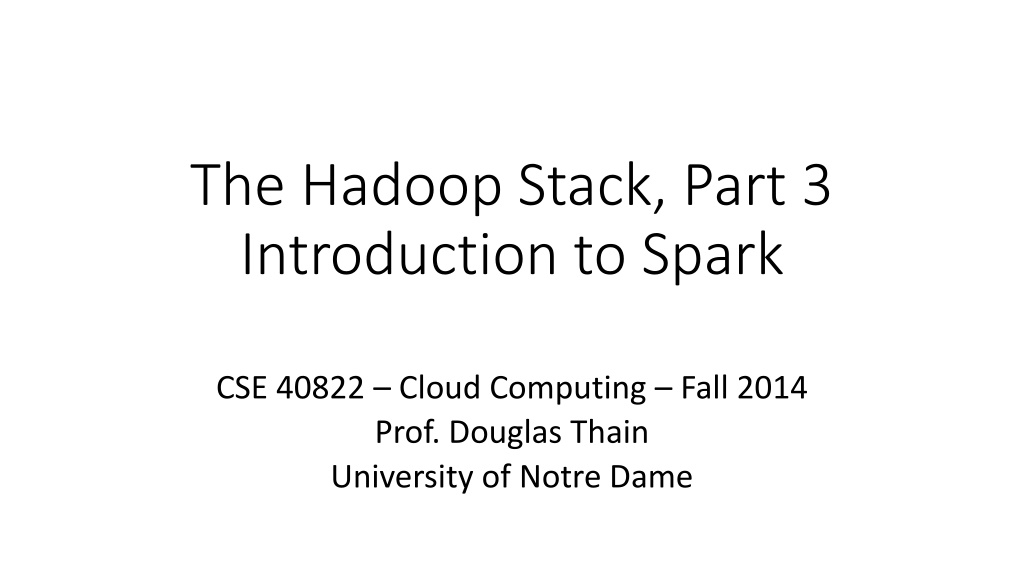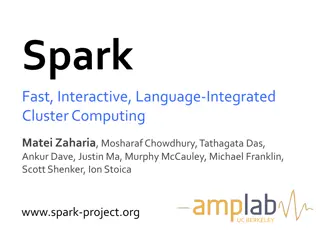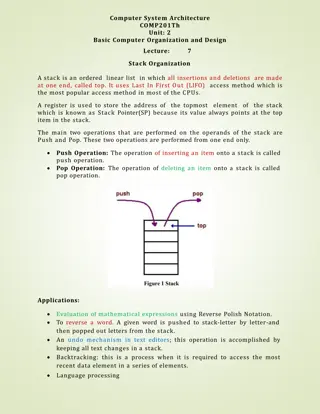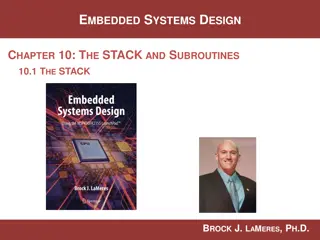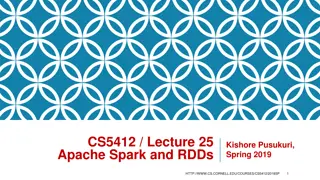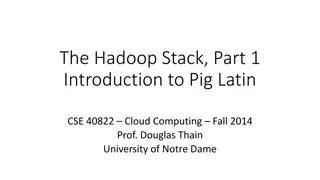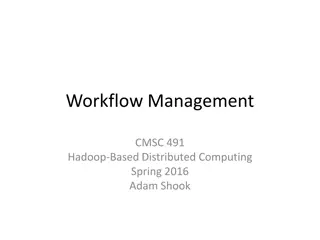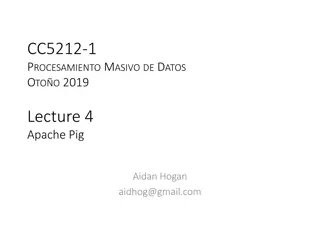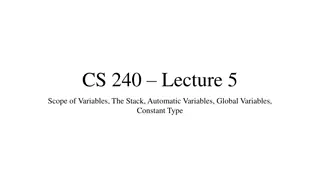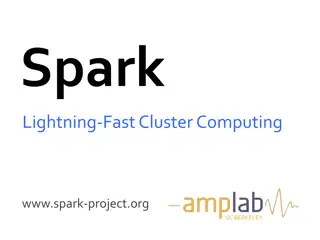Introduction to Spark in The Hadoop Stack
Introduction to Spark, a high-performance in-memory data analysis system layered on top of Hadoop to overcome the limitations of the Map-Reduce paradigm. It discusses the importance of Spark in addressing the expressive limitations of Hadoop's Map-Reduce, enabling algorithms that are not easily expressed in Map-Reduce. The content covers Three Case Studies on workflow, storage with HBase, and execution using Spark, highlighting Spark's role in achieving fault tolerance through re-execution and leveraging Hadoop as a persistence layer. Additionally, it references key works on Spark by Matei Zaharia and Holden Karau, emphasizing the need for a more expressive and efficient approach beyond the traditional Map-Reduce framework.
Download Presentation

Please find below an Image/Link to download the presentation.
The content on the website is provided AS IS for your information and personal use only. It may not be sold, licensed, or shared on other websites without obtaining consent from the author.If you encounter any issues during the download, it is possible that the publisher has removed the file from their server.
You are allowed to download the files provided on this website for personal or commercial use, subject to the condition that they are used lawfully. All files are the property of their respective owners.
The content on the website is provided AS IS for your information and personal use only. It may not be sold, licensed, or shared on other websites without obtaining consent from the author.
E N D
Presentation Transcript
The Hadoop Stack, Part 3 Introduction to Spark CSE 40822 Cloud Computing Fall 2014 Prof. Douglas Thain University of Notre Dame
Three Case Studies Workflow: Pig Latin A dataflow language and execution system that provides an SQL- like way of composing workflows of multiple Map-Reduce jobs. Storage: HBase A NoSQl storage system that brings a higher degree of structure to the flat-file nature of HDFS. Execution: Spark An in-memory data analysis system that can use Hadoop as a persistence layer, enabling algorithms that are not easily expressed in Map-Reduce.
References Matei Zaharia et al, Spark: Cluster Computing with Working Sets, USENIX HotCloud 2010. http://dl.acm.org/citation.cfm?id=1863103.1863113 Holden Karau et al., Learning Spark : Lightning-Fast Big Data Analytics, O Reilly 2014. http://shop.oreilly.com/product/0636920028512.do Apache Spark Documentation http://spark.apache.org
Overview The Map-Reduce paradigm is fundamentally limited in expressiveness. Hadoop implementation of Map-Reduce is designed for out-of-core data, not in-memory data. Idea: Layer an in-memory system on top of Hadoop. Achieve fault-tolerance by re-execution instead of replication.
Map-Reduce Limitations As a general programming model: It is perfect . If your goal is to make a histogram from a large dataset! Hard to compose and nest multiple operations. No means of expressing iterative operations. Not obvious how to perform operations with different cardinality. Example: Try implementing All-Pairs efficiently. As implemented in Hadoop (GFS): All datasets are read from disk, then stored back on to disk. All data is (usually) triple-replicated for performance. Optimized for simple operations on a large amount of data. Java is not a high performance programming language.
A Common Iterative Pattern in Data Mining X = initial value for( i=0; ; i++ ) { set Si+1= apply F to set Si value X = extract statistic from Si+1 if( X is good enough ) break; } On Board: Implement in Map-Reduce Can we do better?
The Working Set Idea Peter Denning, The Working Set Model for Program Behavior , Communications of the ACM, May 1968. http://dl.acm.org/citation.cfm?id=363141 Idea: conventional programs on one machine generally exhibit a high degree of locality, returning to the same data over and over again. The entire operating system, virtual memory system, compiler, and micro architecture are designed around this assumption! Exploiting this observation makes programs run 100X faster than simply using plain old main memory in the obvious way. (But in Map-Reduce, access to all data is equally slow.)
The Working Set Idea in Spark The user should identify which datasets they want to access. Load those datasets into memory, and use them multiple times. Keep newly created data in memory until explicitly told to store it. Master-Worker architecture: Master (driver) contains the main algorithmic logic, and the workers simply keep data in memory and apply functions to the distributed data. The master knows where data is located, so it can exploit locality. The driver is written in a functional programming language (Scala), so let s detour to see what that means.
Detour: Pure Functional Programming Functions are first class citizens: The primary means of structuring a program. A function need not have a name! A function can be passed to another program as a value. A pure function has no side effects. In a pure functional programming language like LISP There are no variables, only values. There are no side effects, only values. Hybrid languages that have functional capabilities, but do not prohibit non-functional idioms: Scala, F#, JavaScript
By the way, Map-Reduce is Inspired by LISP: map( (lambda(x)( * x x )) (1 2 3 4) ) reduce( (lambda(x y) (+ x y)) (1 2 3 4) )
Functions in Scala: Example code: Define a function in the ordinary way: def name (arguments) { code } def oncePerSecond(callback: () => Unit) { while( true ) { callback(); Thread sleep 1000 } } Construct an anonymous func as a value: ( arguments ) => code def main(args: Array[String]) { oncePerSecond( ) } () =>println("time flies like an arrow...") Accept an anonymous func as a parameter: name: ( arguments ) => code A Scala Tutorial for Java Programmers: http://www.scala-lang.org/docu/files/ScalaTutorial.pdf
Parallel Operations in Scala val n = 10; for( i <- 1 to n ) { // run code each value of i in parallel } var items = List(1,2,3); for ( i <- items ) { // run code for each value of i in parallel }
Back to Spark, Using Scala A program to count all the error lines in a large text file: val file = spark.textFile( hdfs://path/to/file ); val errs = file.filter(_.contains( ERROR )); val ones = errs.map( _ => 1 ); val count = ones.reduce( _+_ ); val file = spark.textFile( hdfs://path/to/file ); val errs = file.filter( (x) => x.contains( ERROR )); val ones = errs.map( (x) => 1 ); val count = ones.reduce( (x,y) => x+y ); _ means the default thing that should go here. On Board: Implement in Spark
Logistic Regression in Spark val points = spark.textFile( ).map(parsePoint).cache() var w = Vector.random(D) for( i <- 1 to ITERATIONS ) { val grad = spark.acculmulator( new Vector(D) ) } for( p <- points ) { val s = (1/(1+exp(-p.y*(w dot p.x)))-1)*p.y grad += s * p.x } w -= grad.value
Fault Tolerance via Recomputation (Work out on the board.)
Result: Spark is 10-100X faster than Hadoop on equivalent iterative problems. (It does everything in memory instead of disk.)
